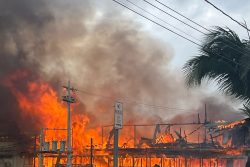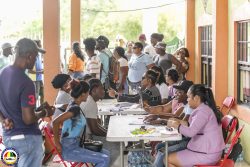Dear Editor,
I am weary of the Guyana Police Force presenting their so-called crime statistics with the intention of creating the impression that serious crime is under control and that the police are doing a good job. According to the release, serious crime is down by 13 percent while murder increased by 37 percent as compared to the same period last year. Even if that is so, crime is too high in Guyana and the fear of crime is perpetual. The President blamed the increase in murder to the fire at the Mahdia Secondary School Dormitory where twenty students burned to death. I am not certain if the police recorded that event as murder or a fire. I would not be surprised if it is the latter. This is based on their recording of certain traffic events as fatal accidents and fatal incidents. Even if the deaths were classified as murder the percentage increase for that category of serious crime presented by the police must be much higher.
Here is the list of serious crimes under review by the police that they have been withholding from the public and even some senior movers and shakers of the Guyana Police Force: Murder; Robbery; Robbery under arms where guns were used; Robbery where other instruments were used; Robbery with aggravation; Robbery with violence; Larceny from the person; Rape; Burglary; Break and enter and larceny; and Kidnapping. It is apposite to note that robbery accounts for five of the list of eleven serious crimes under review. Why not just Robbery? Manslaughter is not catered for as well as the following: Possession, cultivation and trafficking marijuana; Possession and trafficking of cocaine; Unlawful possession of firearms; Offences under the Sexual Offences Act 2010 excluding Rape; Trafficking in Person; Felonious Wounding; Offences under the Domestic Violence Act; Cyber Crimes and many others which the general public will consider as serious crimes. There is also the ‘dark figures in crime’, that is to say, crimes committed, but for diverse reasons not reported to the police.
The possibility of ‘Ghosting’ cannot be overlooked – manipulating the logs to make the figures come out ‘right’. I’ve heard stories in the Guyana Police Force as it relates to crime reporting and analysis – “Do not record this crime, it will make our stats look bad”; “Cook the stats so that we will look good.” Many serious crimes are hidden away in the Occurrence Book and Station Diary when they should be recorded in the Crime Book. Hence, in compiling the monthly crime stats, those crimes recorded in the Station Diary and Occurrence Book are not accounted for. The compilation of crime stats on a monthly basis and comparing it with the previous year was initiated over thirty years ago by Commissioner Laurie Lewis as a performance audit. It has not changed despite the fact that crime has evolved. The reality is that crime rate is high and there is the constant fear of crime in our country.
Stabroek News Editorial of August 6, 2023 under the heading “Killings” is very instructive. Here is its opening statement, “The killing of Dr. Olato Sam on Friday morning has focused public attention yet again on the danger which lurks our street, the prevalence of guns in the society and the continued inability of the Guyana Police Force to keep citizens safe.” The Embassy of the United States of America in Guyana recently issued a crime advisory, warning its citizens visiting and those residing in Guyana to be aware of the crime situation in Guyana. The Georgetown Chamber of Commerce and Industry issued a recent press statement expressing concerns about the increase in crime and called for a change of leadership in the Guyana Police Force. Other agencies and the man in the street are perturbed over the current crime situation in Guyana.
There are several methods that the police can adopt to find out how well they are performing. Apart from looking at percentage increase and decrease in their questionable list of serious crimes, the police must do deeper analytical work. There are several questions to be asked: Is it a trend? Is it a pattern? Is it a series? Is it a spree? Where are the hot spots? What the police are doing is just a tabulation of a very limited number of what they identified as serious crimes. That procedure do not measure whether or not the activities were completed efficiently and effectively and they do not describe what impact the activities had on the community. Rather than looking at crime rates, number of arrest and response time, the evaluation should assess whether or not the police are fulfilling their mandate as set out in Section 3 (2) of the Police Act Chapter 16;01 and its Mission Statement.
By the way, the police have a new Mission Statement which is more confidential than the RSS report on the ‘Paper Shorts’ execution. If the police want to know how well they are doing, they must find out from the public they swore to serve and protect. Most citizens want to live in safe, orderly neighbourhoods. The police are considered effective when they produce the perception that crime is under control. Reducing the fear of crime is a very important measure. What the police must do is to conduct community surveys which can measure trends and provide positive and negative feedback on the public’s impression of law enforcement. Community surveys are often win-win. Citizens are better served and police received positive feedback. It can be key in establishing communication. It might also help set organisational goals and priorities, identify department strengths and weaknesses, identify areas of improvements and needed training and influence the motivation of employees. May God help the Guyana Police Force.
Sincerely,
Clinton Conway
Assistant Commissioner of
Police (Ret’d)








